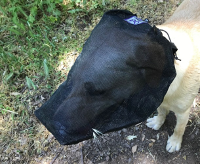
…skilled service…compassionate care
TRAVEL SAFELY WITH PETS
We’ve all seen it, pick-up trucks with pets roaming freely in the back, cars zooming along the highway and the dog’s head is hanging out of the window taking in the breeze. Ironically, sometimes next to the loose dog is a toddler safely strapped into a car seat. What happens to either the child or the dog if and when there is an accident? Theoretically, the child is restrained and protected while the dog becomes a missile, and is bounced around the car at high speeds, hits the windshield, or is even thrown from the car. For example, testing by the Center for Pet Safety in Reston, Virginia, estimates that a “60-pound dog hurtling through the air at 35 miles an hour exerts a force of 2,100 pounds upon hitting an object – or another passenger”.
We all want our pets and other passengers to ride safely with us in the car so before purchasing any harness, crate, or safety equipment for your pet, visit www.centerforpetsafety.org to review their studies, research, and useful information and learn the pros and cons of various pet travel products. This is a non-profit organization and it operates like a Consumers Union for pet safety in cars.

Microchip Your Pet!
How many ways can our pets become lost? A door is left open, a gate is unlatched, a pet pulls away from the leash, loud noises frighten an animal and it runs away, an automobile accident and a possibly injured pet escapes into unfamiliar territory. Maybe your pet has a collar with tags and, hopefully it also has a microchip.
A report presented by the American Veterinary Medical Association (AVMA), states that, “a study of more than 7,700 stray animals at animal shelters showed that dogs without microchips were returned to their owners 21.9% of the time whereas microchipped dogs were returned 52.2% of the time. Likewise, cats without microchips were reunited with their owners only 1.8% of the time, yet 38.5% of microchipped cats went back home.”
We at strongly urge you to microchip your pet. Frequently, we are asked to scan a found pet to see if it has a microchip. If it does, we are glad to reunite the pet and owner. It is very frustrating however, when we find a chip only to realize the owner has failed to register the chip with the chip company, or the owner has not updated contact information. Animal shelter numbers show that microchipped animals for whom owners could not be found, the main reasons were incorrect or disconnected phone numbers. What can you do to help your pet? Please, microchip your pets, register the information with the chip company and update it as needed.
Pet Safety
- Microchip your pet
- Register the microchip and keep the information updated
- Ask us to scan your pet’s microchip at least once a year to be sure it is functioning and can be detected
Coming Out of COVID Restrictions?
We are navigating the COVID-19 sheltering and safe distancing restrictions and when the Health Officer determines restrictions may be reduced, getting outside and exercising more with your pets is at the top or near the top of everyone’s list of things to do.
Fortunately, some pets are getting out on regular walks because the owners are at home more and have the time to walk. Other pets are getting too many treats while owners are home and are becoming pudgy. Even a bit of a weight gain can affect the joints, the cardiovascular system and more. Ease your pet back into an exercise program. You know your pet best. If he is a real couch potato, take it easy from the start. Do not allow your pet to become overheated or overexerted as you increase your activities.
Kodi’s Kolumn! by Kodiak (Kodi) Bibb – Head K-9 in charge! (That’s me, the big one on the left!)
I am testing a new reporter. Let me introduce my super protégé, Roo, the writer of “Roo’s News”. She will carry on my work with true Labrador determination and with her own spin; afterall, I trained her myself so I know she will be great! I hope to get good reviews about Roo!
As the head K-9 around here who knows the most about K-9 noses and how super they are, did you know that eight Labrador Retrievers, just like me, at the University of Pennsylvania are engaged in a research project to determine if they can detect an odor associated with the virus that causes COVID-19? If they are successful, they can add COVID-19 screening to their work at airports, or other public venues. I give these dogs and the thoughtful folks at U of P a big tail wag!

FOXTAIL PREVENTION WARNING – Roo’s First Report!

Hi Folks! Welcome to Roo’s News. This is the time of year for foxtails to get into your pets’ eyes, ears, noses, toes, skin. If you are in foxtail risky areas, some folks are using the face netting from Outfoxedfordogs.com, for the pets. That’s me wearing the Outfoxed face netting. Look at those foxtails stuck in the side. I’m sure glad they didn’t make it through the netting. While helpful at preventing foxtails from entering eyes and ears, etc, be mindful if hiking in heat, dogs can overheat wearing these, and need to be given frequent water breaks to prevent heat related stress. Also, foxtails can still enter my toes, skin, anus and other areas, so whether or not you use the face netting on your dog, don’t forget to check your dogs thoroughly from bottom to top and head to toe after a walk. Have fun!
Heat Issues for Pets
NEVER LEAVE YOUR PET IN A HOT CAR!!!


Always be aware of potential hazards and don’t put your pets in circumstances that may overheat and harm them. Regardless of where you are, exercising outside on a warm day or if your pet is in the car, look for the following signs to determine if your pet is suffering from heat stroke; heavy panting, glazed eyes, rapid pulse, unsteadiness on his feet, vomiting, or deep red or purple tongue. If you see any of these signs, move to a cooler AND:
- Gradually lower your dog’s body temperature by applying cool (not cold) water all over the body or soaking in a cool bath.
- Place cool, wet towels on the head, over the back of the neck, in the armpits, and in the groin area. You may also wet the ear flaps and paws with cool water. Direct a fan on the wet areas to speed evaporative cooling.
- Offer fresh, cool water in small amounts if your dog is alert and wants to drink. Do not force your dog to drink.
- Get your pet to the veterinarian as soon as you can; it could save his life.
ATTENTION RABBIT OWNERS!
The California Fish and Wildlife Department has confirmed the presence of Rabbit Hemorrhagic Disease virus type 2 in wild black-tailed jackrabbits in southern California. This disease is lethal to wild and domestic rabbits, but does not affect humans or domestic animals other than rabbits. This is a very virulent disease and infected rabbits generally show no symptoms before suddenly dying.
The California Fish and Wildlife Department states in part, It’s important to note that while dogs and cats can’t catch RHDV2, they can inadvertently transport it elsewhere. The virus lives a long time, so if…a dog sniffed a rabbit that died of RHDV2, and was then taken to another park or wildlife area, the virus could very easily spread to another habitat.
If you are hiking and notice dead or dying rabbits, please make note of the exact location, do not touch them, and notify the California Fish and Wildlife Department as soon as possible at www.wildlife.ca.gov. Public reports are an extremely helpful tool as wildlife veterinarians monitor the situation. CDFW is asking anyone who lives, works or recreates in wild rabbit habitat to report any sightings of sick or dead rabbits to CDFW’s Wildlife Investigations Laboratory. To report sightings of sick or dead wild rabbits, hares, or pikas contact the CDFW Wildlife Investigations Lab at (916) 358-2790 or file an online mortality report through CDFW’s website.
If you own domestic rabbits, please keep them away from potential connection with wild rabbits. While this disease has only been reported in Southern California, predator species that depend on rabbits for food may help spread the disease.
A vaccine for RHDV2 is not currently available in the U.S., thus domestic rabbit owners should practice good biosecurity measures to protect their animals from this disease, such as washing hands before and after working with rabbits, not sharing equipment with other owners and keeping their rabbits isolated from wild or feral rabbits. Domestic rabbit owners who have a sick rabbit should contact their veterinarian. If domestic rabbits are found dead, please contact the local CDFA Animal Health Branch or call (916) 900-5002. The National House Rabbit Society has some great info for rabbit owners which can be found on their website at https://rabbit.org/.
DATES TO REMEMBER
SHE’S BAAAAAAACK!!! – Dr. Waller’s In the House!
Dr. Waller returned to El Gato on May 28 and will be up and running for appointments Wednesdays through Fridays, but only from 2 – 5 pm. We are so glad to have you back.
June is National Pet Preparedness Month
Responding to the COVID-19 outbreak has shown us that regardless of the emergency or disaster, we must be prepared to deal with the effects of shortages of food, supplies and drugs for people and pets and this includes preparing with our pets in mind. Please visit www.redcross.org or https://www.ready.gov/pet-toolkit to get great family and pet preparedness tips. Now is a great time to restock your food and supplies or revise your emergency plans. Stay safe.
June 7 – 13 is Pet Appreciation Week
Pets are sweet and wonderful, and yes, at times they can be difficult or troublesome, but we are so much better off having them in our lives – even for a short time. Take a moment and give your special pet(s) a hug and a big thank you that you share life together. All will be all the happier for it.
June 21, Father’s Day
If we are able to get close to our loved ones by June 21, give that special father figure in your life a big hug. If we are still practicing social distancing, wave, make a phone call, do an online chat and let him know you care.
June 21 – 27, National Pollinator Week
Pollination is a vital stage in the life cycle of flowering plants. The transfer of pollen by pollinators is necessary for the survival of a healthy ecosystem. In the U.S. pollination produces nearly $20 billion worth of products annually. Did you know that about 1,000 of all pollinators are vertebrates such as birds, bats, and small mammals, and about 200,000 species are beneficial insects such as flies, beetles, wasps, ants, butterflies, moths, and bees? Go to https://www.pollinator.org for tips on helping pollinators keep our food supply growing and get great ideas for things kids can do to help pollinators thrive in our community.


